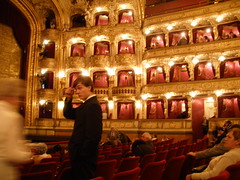Coffee is so interwoven with Western and near-Eastern culture that its rightful place is as the flip side of wine: stimulating instead of sedating, steaming instead of cool, bitter rather than sweet, normally taken in the morning rather than the evening. Like wine it is normally found around food, at casual and formal occasions, often is accompanied by a ritual, but seems like a good idea anytime we feel like it. And the second helping is never as divine as the first.
Both encourage dependencies and in excess are clear vices. However, while the benefits of moderation in wine have been proved over and over (not least its anti-aging, anti-oxidative and letting-your-mother-know-what-you-really-think properties) the judgment on coffee is less clear cut.
A dear friend who – when she is not nursing patients – nurses a coffee habit of legendary proportions, once said that she could speak for five minutes and convince anyone that they should never again take another sip of coffee. This, she said, could be followed by another five minutes in which she could convince the same person that they should never let anything come between them and their two daily cups.
I'm not satisfied with this ambiguity though. Even more unsatisfying, something is awry with the way I make coffee these days. I (as usual) use a cone filter, ground espresso from the CoOp and have not noticeably changed the recipe – but it just is not tasting the same. Every morning tea is looking a little bit better, though I've been hesitating to trust it to get the job done. All this makes it imperative for me to know: cutting through the crap, is coffee good for you or is it bad for you?
But, as a deviation before I get in to that, I found a wonderful legend about coffee’s origins cultivation from National Geographic's Web site. It goes along these lines:
“Goats will eat anything. Just ask Kaldi the legendary Ethiopian goatherd. Kaldi, the story goes, noticed his herd dancing from one coffee shrub to another, grazing on the cherry-red berries containing the beans. He copped a few himself and was soon frolicking with his flock.
“Witnessing Kaldi’s goatly gambol, a monk plucked berries for his brothers. That night they were uncannily alert to divine inspiration.”
Alright, back to the science. Here is what I found:
According to the National Coffee Association’s Coffee Science Source (CoffeeScience.org) coffee seems to reduce the risk of Type 2 Diabetes, Alzheimer’s and Parkinson’s. There is some evidence that it can improve physical performance when exercising (types the girl who is meant to be training for a half marathon) and protects against heart disease and cirrhosis of the liver. Coffee’s fiber and antioxidants help keep our colons and DNA young.
The articles warning against coffee seem to be slightly more of the “paranoid wing-nut” variety. They mainly point out the dangers of adrenal exhaustion, psychological dependences and “dead caffeine” (as opposed to live caffeine in green tea – give me a break).
So . . . my coffee problem seems mainly to be that I need to invest in a better coffee maker!
Further reading:
Coffee as a Health Drink? Studies Find Some Benefits (August 15, 2006, NY Times)













